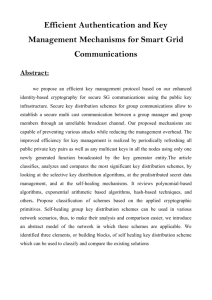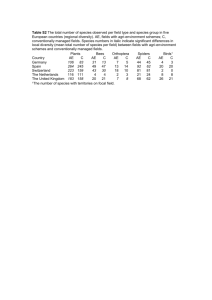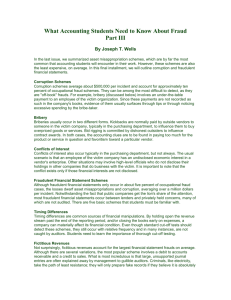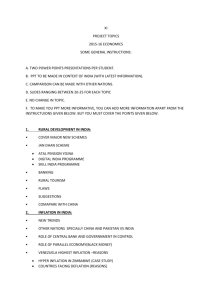I. Introduction to Fraud Examination
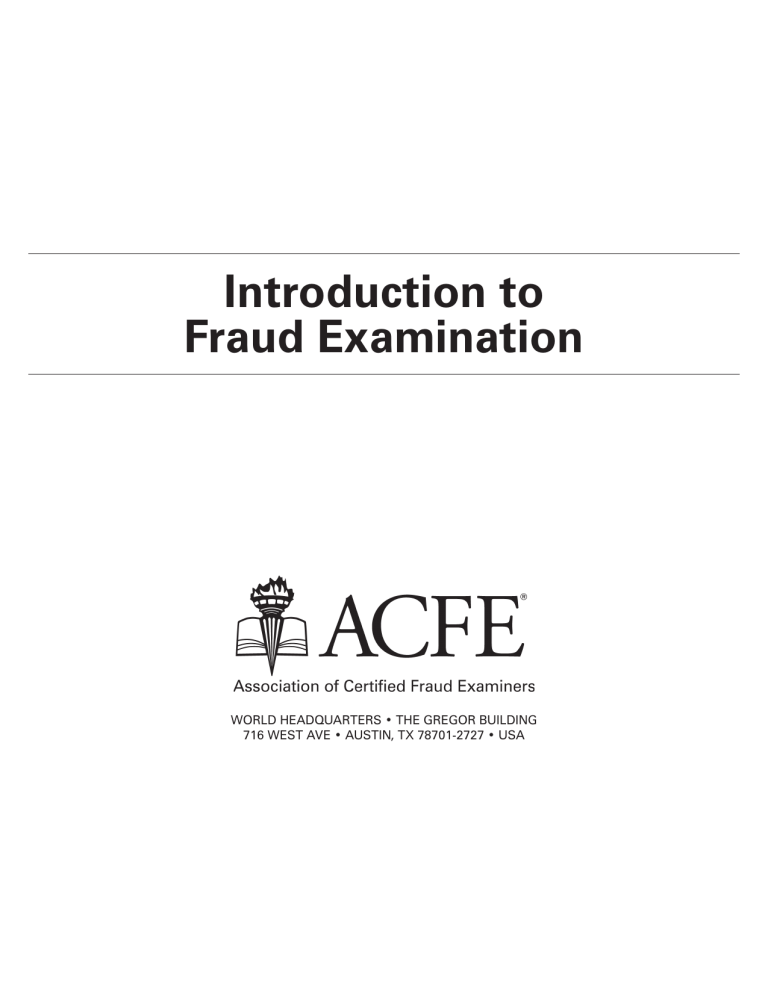
Introduction to
Fraud Examination
World Headquarters • tHe gregor building
716 West ave • austin, tX 78701-2727 • usa
Fraud Schemes
VII. FRAUDULENT FINANCIAL TRANSACTIONS: FRAUD SCHEMES
Introduction
Fraud can be committed internally or externally from a company by employees, customers, vendors, and other parties.
Internal fraud is fraud that originates from within an organization and is committed by employees. External fraud is fraud committed by outsiders; it involves any scheme in which the perpetrator is not an employee, manager, officer, or owner of the victim company. External fraud covers a broad range of schemes, from vendor and customer frauds that attack businesses, to traditional consumer frauds and confidence schemes. This section will provide an overview of some of the most common and threatening internal and external fraud schemes by addressing:
Asset misappropriations
Fraud by vendors
Corruption
Fraudulent financial statements, while a type of internal fraud, will be covered in a separate section.
Asset Misappropriation Schemes
Asset misappropriation schemes include both the theft of company assets, such as cash or inventory, and the misuse of company assets, such as using a company car for a personal trip. The asset misappropriation schemes to be discussed here are:
Cash schemes
Accounts receivable schemes
Inventory
Fixed asset schemes
Cash Schemes
Skimming
Cash larceny
Fraudulent disbursements
Skimming
Skimming is the process by which cash is removed from the entity before it enters the accounting system.
This is an ―off-book scheme‖ because the receipt of the cash is never reported to the entity.
The most common skimming schemes are:
Unrecorded sales
Understated sales
Theft of incoming checks
62 Introduction to Fraud Examination
Fraud Schemes
Swapping checks for cash
Cash Larceny
In the occupational fraud setting, a cash larceny may be defined as the intentional taking away of an employer‘s cash (the term cash includes both currency and checks) without the consent and against the will of the employer. Skimming was defined above as the theft of off-book funds. Cash larceny schemes, conversely, involve the theft of money that has already appeared on a victim company‘s books.
Therefore, cash larceny schemes are ―on book‖ frauds.
Fraudulent Disbursements
Fraudulent disbursements are the most common form of asset misappropriation, and they occur when an employee uses his position of employment to cause a payment for some inappropriate purpose.
Fraudulent disbursements are on-book fraud schemes, meaning that cash (checks) leaves the entity fraudulently, but it is recorded on the books and thus an audit trail exists. Fraudulent disbursement schemes are broken down into the following types:
Check tampering schemes
Register disbursement schemes
Billing schemes
Expense reimbursement schemes
Payroll schemes
CHECK TAMPERING SCHEMES
Check tampering is a type of fraudulent disbursement scheme whereby an employee either (1) prepares a fraudulent check for his own benefit or (2) intercepts a check intended for a third-party and converts the check to his own benefit. Other fraudulent disbursement schemes, such as false billings or payroll fraud, tend to rely on false claims for payment. Some false document, perhaps an invoice or a timecard, is submitted to the victim organization and generates the fraudulent payment. Such schemes are based on trickery—convincing the victim to make a payment based on a fraudulent invoice, timecard, expense report, or other document.
Check tampering schemes are a more direct form of fraud. Instead of relying on false support to generate a fraudulent disbursement, the perpetrator of a check tampering scheme takes physical control of a check and places false information on that instrument. The fraudster might forge a signature, alter a payee, alter the amount of the check, and/or forge an endorsement. The key is that the perpetrator places false information on a company check and that this action enables the fraudster to illegally obtain funds from his employer.
Introduction to Fraud Examination 63
Fraud Schemes
Check tampering frauds depend on factors such as access to the company checkbook, access to bank statements, and the ability to forge signatures or alter other information on the face of the check. Check tamperers commit fraud by identifying and exploiting weaknesses in an organization‘s check-writing processes.
The major methods of check tampering are:
Forged maker schemes
Forged endorsement schemes
Altered payee schemes
Concealed check schemes
Authorized maker schemes
REGISTER DISBURSEMENT SCHEMES
Refunds and voided sales are transactions processed at the register when a customer returns an item of merchandise purchased from that store. The transaction entered on the register indicates the merchandise is being replaced in the store‘s inventory and the purchase price is being returned to the customer. In other words, a refund or void shows a disbursement of money from the register as the customer gets his money back.
Fraudulent refunds and voids represent a class of occupational fraud that is a hybrid between cash theft and fraudulent disbursements. Since these schemes appear on the books as legitimate disbursements of funds from the cash register, they are classified as fraudulent disbursements. In practice, an employee physically removes cash from his cash register and absconds with it. In that respect, such schemes are very similar to cash larceny schemes.
BILLING SCHEMES
The most common and costly example of a fraudulent disbursement is the billing scheme. Billing schemes attack the purchasing function of an organization. They cause the victim organization to buy goods or services that are nonexistent, overpriced, or not needed by the organization.
A billing scheme can result in an illicit gain of cash, goods, or services for the fraudster. The purpose of most billing schemes is to generate cash. In a typical scheme, the perpetrator creates false support for a fraudulent purchase. The fraudulent support documents, which can include invoices, purchase orders, purchase requisitions, receiving reports, and so on, cause the victim organization to issue a check. The fraudster collects the check and cashes it, thereby reaping an illegal gain.
Employees can use utilize false billings to receive goods or services rather than cash. In these cases, the fraudster makes a personal purchase and charges it to his employer as if the purchase were a business
64 Introduction to Fraud Examination
Fraud Schemes expense. This type of scheme is accomplished in one of two ways. One method is to run a voucher for a personal purchase through the payables system. The perpetrator misrepresents the nature of the purpose, claiming that the goods or services are being bought on the company‘s behalf. The second method is to purchase personal goods or services on the company‘s credit card or on a credit account.
The major categories of billing schemes are:
Shell company schemes
Overbilling involving existing vendors
Personal purchases with company funds
EXPENSE REIMBURSEMENT SCHEMES
Travel and expense budgets are a common target for occupational fraud. Employees may falsify information about their business expenses and cause their employers to overcompensate them in the form of inflated expense reimbursements. This type of scheme is most commonly perpetrated by sales personnel who overstate or create fictitious expenses in areas such as client entertainment and business travel. Outside sales personnel are not the only employees who commit this type of fraud, however. Any person who is in a position to incur travel or business entertainment expenses is potentially capable of committing expense reimbursement fraud.
Expense reimbursement schemes fall into four general categories:
Mischaracterized expense reimbursements
Overstated expense reimbursements
Fictitious expense reimbursements
Multiple reimbursements
PAYROLL SCHEMES
Payroll schemes occur when an employee fraudulently generates overcompensation on his behalf. These schemes are similar to billing schemes in that the perpetrator generally produces some false document or otherwise makes a false claim for a distribution of funds by his employer. In billing schemes, the false claim typically comes in the form of a fraudulent invoice. In payroll schemes, the false claim generally occurs when the fraudster falsifies payroll records, timekeeping records, or some other document concerned with the payroll function.
The most common forms of payroll fraud are:
Ghost employee schemes
Falsified hours and salary
Commission schemes
Introduction to Fraud Examination 65
Fraud Schemes
Accounts Receivable Fraud Schemes
Accounts receivable is very vulnerable to fraud. It is an enabler for financial statement fraud schemes and asset misappropriation schemes. The most common fraud schemes in accounts receivable are:
Lapping
Fictitious receivables
Improper posting of credits
Lapping
Lapping , one of the most common fraud schemes, is the recording of payment on a customer‘s account sometime after the payment has been received. In a typical scenario, Customer A‘s payment is diverted;
Customer B makes a payment, but it is credited to Customer A‘s account. When Customer C makes a payment, it is credited to Customer B‘s account.
Lapping Scheme
Customer
A
Owes $100
Customer A
Pays $100 –
A/R clerk pockets the money
Customer
B
Owes $100
Customer B
Pays $100
Customer
C
Owes $100
Customer
C pays
$100
Customer A is credited
$100 –
Owes 0
Customer B is credited
$100 – Owes
0
Customer C owes $100 on the books
Fictitious Receivables
Fictitious accounts receivables are usually set up to disguise fictitious sales. Once a sale is booked, the corresponding journal entry is to a receivable that is never collected and eventually written-off.
Improper Posting of Credits
In this scheme, a credit is posted in a customer‘s account either as a discount, return, or write-off of the account. This is to cover up a theft, but it also may be a fraud in itself. For example, for an account that has been written-off, the employee may collect the receivable and then divert the funds to himself.
66 Introduction to Fraud Examination
Fraud Schemes
Inventory Fraud Schemes
Most inventory and warehousing frauds involve misappropriating inventory for personal use, stealing inventory and scrap, or charging embezzlements to inventory.
Appropriating Inventory and Supplies for Personal Use
How many times have we heard someone say, ―I‘m just going to borrow this,‖ or ―I took it home to work on the project over the weekend?‖ In fact, a great deal of inventory is stolen under the pretense that it is being borrowed. In actuality, the inventory is being converted to personal use.
Stealing Inventory
Inventory is also stolen for sale to outsiders. Among many ways to convert stolen inventory into cash, the inventory may be sold at an employee‘s own business, at flea markets, or at garage sales to unknowing purchasers or to co-conspirators.
Theft of Scrap Proceeds
The theft of scrap-sale proceeds is a common practice. Because the amounts are generally insignificant to the financial statements of the company, scrap sales are usually not well controlled and inventory documentation is not well kept.
Fixed Asset Schemes
Fixed assets are the company‘s property, plant, and equipment. Often, fixed assets are the targets of employee theft and unauthorized personal use. Fixed assets that are easily removed from the premises
(such as tools and computers) are especially prone to employee theft.
Another common type of fixed asset scheme is the unauthorized personal use of fixed assets by employees. This is especially true for fixed assets that are easily removed from the company premises.
For example, the personal use of computers or company-owned vehicles can develop into a fraud or an abuse situation if the subject is not addressed. In addition, the loss of productive time might be more costly than the improper usage of the asset itself.
Fraud by Vendors
Bid-Rigging and Market Division Schemes
Often, in contracting for the supply of goods and services, two or more vendors—or in some cases employees—collude to circumvent the competitive bidding process. When this happens, prices are inflated and the procuring entity is cheated out of its right to the benefits of free and open competition.
The most common forms of collusion between competitors involve bid-rigging and market division
Introduction to Fraud Examination 67
Fraud Schemes schemes. Each of these schemes are per se violations of the Sherman Act (15, U.S.C., § 1 et seq .), which prohibits competitors from entering into any agreement to restrain trade in interstate commerce, including bid rigging and market-division schemes.
Bid-Rigging
Competitive procurement methods require that contractors competitively bid on contracts; however, in bid-rigging schemes, competitors in the same market conspire to defeat competition or to artificially inflate the prices of goods and services. Essentially, through bid-rigging, vendors create a situation where the procuring entity overpays for what it receives.
Bid-rigging schemes can take many forms, and they relate to one another and overlap. In many instances, an agreement to rig bids will involve more than one type of scheme. Some of the more common bid-rigging schemes are:
Bid rotations
Bid suppression
Complementary bids
BID ROTATIONS
In bid rotation schemes, two or more contractors collude to alternate the business between them on a rotating basis. In basic terms, the contractors involved in the scheme agree to take turns being the lowest bidder on a series of related contracts. Employees of the procuring entity are not involved in most instances of bid rotation.
To commit these schemes, corrupt contractors may submit intentional high bids, complimentary competitive bids (i.e., those that are not serious attempts to win), refrain from bidding, or agree to withdraw a previously submitted bid.
Additionally, bid rotation schemes may be coupled with a scheme to award subcontracts to losing bidders. This allows losing bidders to improve their cash flow as they wait for their turn to win.
Similarly, losing bidders might receive a percentage of the winning company‘s profits.
In its most basic form, bid rotation will consist of a cyclical pattern for submitting the low bid on certain contracts; however, the rotation can be based on various factors. The competitors may take turns on contracts according to the geographic area (e.g., one road contractor gets all the work in one county, another company in the next), the identity of the customer, the type of job, the contract size, etc.
However, the cyclical pattern may not be as obvious as might be expected if it is coupled with a scheme to award subcontracts to losing bidders.
68 Introduction to Fraud Examination
Fraud Schemes
BID SUPPRESSION
For bid rigging schemes to succeed, the number of bidders must be limited and all must agree to the conspiracy. If a new or uncooperative bidder enters the competition, the price inflation will become apparent. To prevent this, the conspirators may pay off outside companies not to bid or use more forceful means to discourage their participation. For example, the conspirators may fabricate bid protests or coerce suppliers and subcontractors not to deal with non-conspirators who submit bids.
COMPLEMENTARY BIDS
Complementary bidding, also known as protective or shadow bidding, occurs when competitors submit token bids that are not serious attempts to win. To perpetrate this type of scheme, conspirators might agree to submit bids that are too high to be accepted, bids that appear to be competitive in price but deliberately fail to meet other requirements of the tender, or bids that contain special terms that will not be acceptable to the buyer. Such bids are not intended to secure the buyer‘s acceptance; they are merely designed to give the appearance of genuine bidding.
Market Division
Market division schemes are agreements in which competitors divide markets among themselves and refrain from competing in each other‘s designated portion of the market. Markets are generally divided according to geographic area or based on the customer. The result of such a division is that competing firms will not bid against each other, or they will submit only complementary bids when a solicitation for bids is made by a customer or in an area not assigned to them. The customer thereby loses the benefit of true competition and ends up paying a higher price than would be dictated by fair bidding under normal economic forces.
Market division is sometimes concealed by the submission of bids from shell companies (i.e., companies that have no physical presence and generate little to no independent economic value). The corrupt vendor submits its own bid along with bids from fictitious vendors to create the appearance that there is competition for the contract, when in fact, only one supplier is actually bidding.
Overbilling Schemes
Overbilling occurs when a vendor submits inflated invoices charging in excess for goods or services.
The vendor may simply raise the price of goods or services above the contractual level, hoping the customer will not catch the overcharge. It is also common for corrupt vendors to bill for more merchandise than is actually delivered or to change the date on a legitimate invoice and re-bill it, thus collecting two or more times for the same goods or services.
Overbilling schemes may or may not involve collusion with someone within the victim company. When an employee of the victim is involved in the scheme, he usually receives kickbacks in return for
Introduction to Fraud Examination 69
Fraud Schemes participating. Kickback schemes will be discussed in more detail below. In cases where the vendor acts without inside assistance, these schemes depend entirely upon weaknesses in the victim‘s internal control structure for their success. Proper authorization on purchases and review of support documentation before issuing payment will defeat most stand-alone overbilling schemes.
Shell Companies
Shell companies are vendors who only exist on paper; their only purpose is to bill businesses for services not rendered or products not delivered. Typically, unless a company insider is involved, the fraudster simply sends a bogus invoice to the victim organization‘s accounting department in hope that it will be paid. Although these schemes take a variety of forms, the most common one involves office supplies or toner. The fraudster counts on businesses to send a check without actually confirming whether the product was received. This type of scheme generally works on a saturation method; invoices are sent out
70 Introduction to Fraud Examination
Fraud Schemes to dozens or hundreds of companies with the expectation that a certain percentage will pay the fraudulent bills.
Collusion Between Vendors and Employees
Fraud by vendors is especially dangerous when the vendor is conspiring with an employee of the victim organization. Collusion between vendors and employees generally takes the form of kickbacks or illegal gratuities.
Kickbacks
Kickbacks are undisclosed payments made by a third-party to a company‘s employees. They are classified as corruption schemes because they involve collusion between employees and vendors.
In a common type of kickback scheme, a vendor submits a fraudulent or inflated invoice to the victim organization and an employee of that organization helps make sure that a payment is made on the false invoice. For his assistance, the employee-fraudster receives a payment from the vendor. This payment is the kickback.
Kickback schemes almost always result in the victim company being overbilled. The false invoices either overstate the cost of actual goods and services, overstate the quantity of goods sold or delivered, or reflect completely fictitious sales. Usually, the amount of the kickback is included in the contract price so that the victim company bears the cost of the illegal payment.
Illegal Gratuities
Illegal gratuities are something of value given to an employee to reward a decision after it has been made rather than influence it before the decision is made. This crime is similar to bribery except that an illegal gratuity does not require proof of intent to influence the employee‘s decision-making. Instead of paying an employee to make a decision (e.g., award a contract), the vendor pays the employee because of a decision the employee previously made. Illegal gratuities are merely offered as a ―thank you‖ for something that has been done. In proving an illegal gratuity, there is no need to show that the vendor intended to influence the employee‘s actions; it is enough to show that the employee accepted an award based on his performance.
Detection
The following red flags are generally associated with fraud by vendors:
Complaints from employees or other vendors
After bids are rejected as too high, the same bidders re-bid in the same bid rank
Bid prices drop when a new bidder submits a bid
Introduction to Fraud Examination 71
Fraud Schemes
Qualified contractors refrain from bidding
Certain contractors always bid against each other or never bid against each other
The successful bidder subcontracts to losing bidders
There is a geographical or rotational pattern to winning bidders
Different bidders make the same mathematical or spelling errors
Bidders frequently change prices by comparable amounts at about the same time
Competitors regularly socialize, hold meetings, visit each others‘ offices, travel together, subcontract, and supply with each other
Any statements acknowledging territories, such as, ―we do not bid in ‗X‘ county‖
The winning vendor is always the last to bid
New vendors receive a disproportionate number of winning bids
Unusual or ―one time‖ extra charges
An employee has unexplained lifestyle changes
Expenses have increased considerably for no apparent reason
Shortages of merchandise and supplies
Invoice numbers from the same vendor that occur in unbroken consecutive sequence
Invoices from vendor consistently just under the threshold for higher review and approval
Vendor salespersons make frequent unexplained visits to purchasing employees
Quality of goods declines
Corruption
Corruption is the wrongful use of influence in a business dealing to procure a benefit for the actor or another person, contrary to the duty and/or the rights of others. Corruption occurs in various forms, including bribery, kickbacks, illegal gratuities, economic extortion, collusion, and conflicts of interest.
The recipients of these schemes range from a low-level clerk to a chief executive officer or a public official.
Corrupt payments may be in the form of food and liquor or large cash payments. Whatever the situation, corruption creates an unhealthy situation for businesses.
Methods of Making Illegal Payments
In corruption schemes, the method of payment need not be money and often is not. Any tangible benefit given or received with the intent to corruptly influence the recipient may be an illegal payment.
However, there are certain traditional methods of making illegal payments that fall into the following hierarchical pattern:
Gifts, travel, and entertainment
Cash payments
72 Introduction to Fraud Examination


